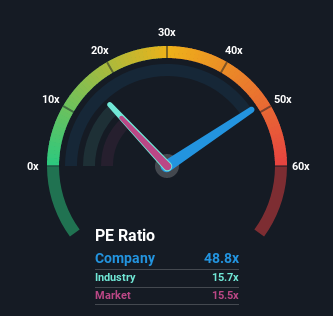National Instruments Corporation (NASDAQ:NATI) shareholders would be excited to see that the share price has had a great month, posting a 25% gain and recovering from prior weakness. But not all shareholders will be feeling jubilant, since the share price is still down a very disappointing 11% in the last twelve months.
Following the firm bounce in price, National Instruments' price-to-earnings (or "P/E") ratio of 48.8x might make it look like a strong sell right now compared to the market in the United States, where around half of the companies have P/E ratios below 15x and even P/E's below 8x are quite common. Nonetheless, we'd need to dig a little deeper to determine if there is a rational basis for the highly elevated P/E.
Recent times have been advantageous for National Instruments as its earnings have been rising faster than most other companies. The P/E is probably high because investors think this strong earnings performance will continue. You'd really hope so, otherwise you're paying a pretty hefty price for no particular reason.

What Are Growth Metrics Telling Us About The High P/E?
There's an inherent assumption that a company should far outperform the market for P/E ratios like National Instruments' to be considered reasonable.
Retrospectively, the last year delivered an exceptional 378% gain to the company's bottom line. However, this wasn't enough as the latest three year period has seen a very unpleasant 31% drop in EPS in aggregate. So unfortunately, we have to acknowledge that the company has not done a great job of growing earnings over that time.
Turning to the outlook, the next three years should generate growth of 33% each year as estimated by the six analysts watching the company. Meanwhile, the rest of the market is forecast to only expand by 10% each year, which is noticeably less attractive.
With this information, we can see why National Instruments is trading at such a high P/E compared to the market. It seems most investors are expecting this strong future growth and are willing to pay more for the stock.
What We Can Learn From National Instruments' P/E?
Shares in National Instruments have built up some good momentum lately, which has really inflated its P/E. It's argued the price-to-earnings ratio is an inferior measure of value within certain industries, but it can be a powerful business sentiment indicator.
We've established that National Instruments maintains its high P/E on the strength of its forecast growth being higher than the wider market, as expected. Right now shareholders are comfortable with the P/E as they are quite confident future earnings aren't under threat. It's hard to see the share price falling strongly in the near future under these circumstances.
It's always necessary to consider the ever-present spectre of investment risk. We've identified 2 warning signs with National Instruments (at least 1 which is significant), and understanding them should be part of your investment process.
If P/E ratios interest you, you may wish to see this free collection of other companies that have grown earnings strongly and trade on P/E's below 20x.
Have feedback on this article? Concerned about the content? Get in touch with us directly. Alternatively, email editorial-team (at) simplywallst.com.
This article by Simply Wall St is general in nature. We provide commentary based on historical data and analyst forecasts only using an unbiased methodology and our articles are not intended to be financial advice. It does not constitute a recommendation to buy or sell any stock, and does not take account of your objectives, or your financial situation. We aim to bring you long-term focused analysis driven by fundamental data. Note that our analysis may not factor in the latest price-sensitive company announcements or qualitative material. Simply Wall St has no position in any stocks mentioned.
The views and opinions expressed herein are the views and opinions of the author and do not necessarily reflect those of Nasdaq, Inc.



%20Earnings%20Pushing%20Shares%2025%25%20Higher%20%7C%20Nasdaq&_biz_n=5&rnd=924043&cdn_o=a&_biz_z=1743338993215)
%20Earnings%20Pushing%20Shares%2025%25%20Higher%20%7C%20Nasdaq&rnd=147741&cdn_o=a&_biz_z=1743338993220)
%20Earnings%20Pushing%20Shares%2025%25%20Higher%20%7C%20Nasdaq&_biz_n=5&rnd=924043&cdn_o=a&_biz_z=1743338996216)